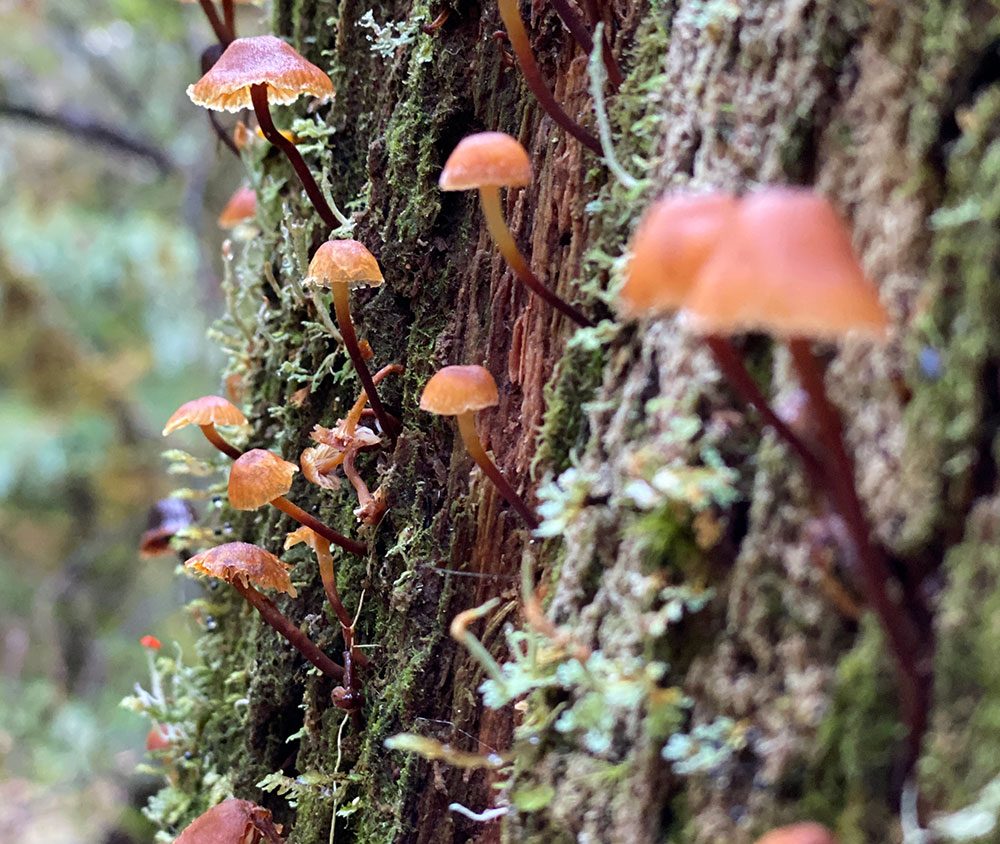In this dark time of year — daylight hours averaging right about nine hours in December and January — I look to nature for light and joy.
I spent part of last Christmas Day hiking on the Larison Creek Trail, a gift my loved ones and I shared together. We touched dew on the mosses and lichens that clung to furrowed tree trunks. We knelt on the soft soil to look closer at the gills of mushrooms. We followed a wildlife trail to the edge of the stream to look for colorful rocks and salamanders. We gazed upward at skeletal alders and maples, bare of leaves but glowing with life. We marveled at sugar pine cones as long as our forearms, and the spiny seed pods of chinquapin trees.
When you go outdoors with a sense of curiosity and exploration, it’s hard to get bored — even if you’ve been on the same trail many times. You can think of each walk as a gift to yourself. What new thing will you discover about the place you live? What new joy will touch your heart? Here are a few things to keep in mind to help you make the most of your experiences:
Look up. The most interesting features along a trail aren’t always at eye level. Looking into the canopy of a forest can lead you to nests, gnarled branches and broken tops that give ancient trees so much character.
Look down. The forest floor is also filled with fascinating life. From ferns and wildflowers, to mushrooms and animal scat.
Look closer. Zooming in on the small things that make up a place gives you a different perspective, and you can find fascinating and beautiful forms often missed by only taking in the big picture.
Learn. Knowing more about the native plants, animals, insects and mushrooms you’re sharing the forest with can help you better understand and appreciate their role in the ecosystem we all share. There are plenty of great books and apps out there where you can learn names, ecological function and cultural uses. If you don’t carry any of these with you, take photos or try to remember what you saw so you can look them up later.
Wonder. It’s fun to be a forest detective while on a hike. Think about why the stream or forest looks the way it does. Why is the bark of that tree blackened? Why is a small clump of young trees growing in one spot? What formed the deep pool in the stream that looks so enticing to swim in?
Take time. Getting exercise on a trail is all well and good, but I guarantee you’ll see more wildlife, hear more birds and be able to soak in more of the experience if you stop periodically or sit awhile along the trail.
The Larison Creek Trail, one of my favorites, is just a few miles outside of Oakridge and accessible year round (unless we get low-elevation snow). It offers great hiking options from three to 12 miles in length.
Managed by the Willamette National Forest as a reserve for old forest habitat, the beautiful forest along this trail has grown naturally for hundreds of years, save for the lower part of the stream that was logged to make way for an arm of Hills Creek Reservoir and a short stretch about four miles in.
The first mile or so of the trail passes in and out of openings on the exposed slope above the reservoir, the warm, dry area supporting incense cedars, sugar pine and madrones. After a mile and a half, the moister forest and giant Douglas-fir trees take over, mixed with hemlocks, Pacific yew, redcedar, and bigleaf maples. The trail gradually gains elevation as it follows Larison Creek, finally reaching a major stream crossing after nearly six miles. Turn back here (if you haven’t already) for a long day hike, and enjoy the forest from another angle on the return trip.
To get there, follow Oregon Route 58 southeast from Eugene to the town of Oakridge. Just past town and the 37-mile marker, turn right (south) onto Forest Road 23 at signs for Hills Creek Dam. In a half mile, turn right onto Road 21 and drive 3.3 miles to the trailhead parking area on the right, just before crossing Larison Cove. There are no restrooms here, and no permit is required.
Chandra LeGue of Eugene is the author of the book Oregon’s Ancient Forests: A Hiking Guide and is the Western Oregon field coordinator for Oregon Wild where she advocates for the protection and restoration of Oregon’s forests and wild places.
